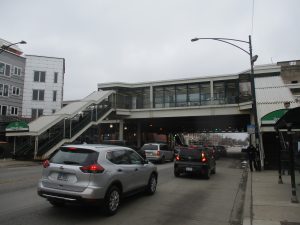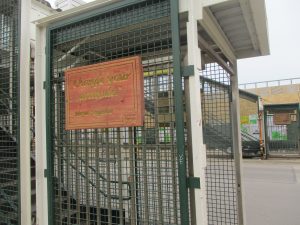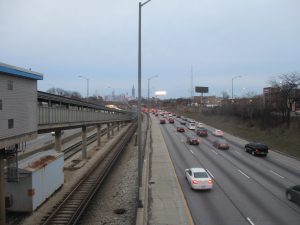Elevated Chicago initiative aims to improve communities
By Igor Studenkov For Chronicle Media — April 10, 2018
An inspirational quote board placed near intersection of Kedzie Avenue and Polk Street, four blocks south of the Kedzie-Homan “L” station’s Kedzie entrance. (Photo by Igor Studenkov/for Chronicle Media)
The name of Elevated Chicago, a community development initiative spearheaded by Metropolitan Planning Council, Enterprise Community Partners Chicago and IFF, refers to two things.
First of all, it refers to the elevated “L” lines. The organizations behind it are focusing their efforts on the blocks within half-mile radius of seven “L” stations in communities that either haven’t seen much development or are in some stage of gentrification. But the name also refers to the idea that they want to improve communities along the “L” tracks by strengthening the power and influence of people who live there. Not only would that improve people’s lives, the organizations argue, but it would help ensure that any development wouldn’t result in displacement of the very people it meant to benefit.
The initiative has been around for three years. And last year, it was able to take major step forward, getting enough funding to issue $700,00 worth of grants until 2020. Ultimately, they hope to support the organizations that share their priorities while ensuring that residents have their voices heard.
Rail lines and community development have gone hand-in-hand in Chicago area for almost as long as trains existed. In the second half of the 19th century, the suburban towns and villages lobbied railroads to put tracks through their territory in hopes that a railroad connection would improve business opportunities and attract residents. Suburbs such as Des Plaines and Lake Bluff still have downtowns centered on Metra stations. The elevated “L” lines had a similar effect — 63rd Street corridor benefitted from the two branches of what is now known as the Green Line, and many west-east commercial strips on the North Side are located along the streets served by “L” stations.

Kedzie/Lake Green Line “L” station is one of the seven stations that Elevated Chicago is focusing on. While the surrounding blocks of East Garfield Park haven’t seen as much investment as neighborhoods further east. Artist lofts popped up by the Union Pacific West Line a few blocks north, and the Hatchery food business incubator is currently being built on the once-vacant lot southeast of the station. (Photo by Igor Studenkov/for Chronicle Media)
The growth of state and national highways changed the dynamic somewhat, with highways playing the similar roles railroads once did. And commercial areas along many Metra and “L” stations within the city struggled. But the last three to four decades saw renewed emphasis of what has come to be known as Transit-Orientated Development, with communities in Chicago and the suburbs developing plans that would encouraged commercial and residential development around transit stations.
As Rosa Ortiz, the co-chair for Elevated Chicago’s steering committee, told the Chronicle that they wanted to take it a few steps further.
“Our focus is to promote racial equality, prosperity and resiliency in Chicago using equitable transit-oriented development,” she said.
As the initiative’s website puts it, the organizations behind it see “L” stations as opportunities to address disparity in terms of resources between poor minority communities and other parts of Chicago, with particular focus on health and the effects of climate change.
As Ortiz explained, Elevated Chicago was a brainchild of three organizations — IFF, a Chicago-based nonprofit financial lender originally launched by the Chicago Community Trust, Metropolitan Planning Council, a decades-old Chicago organization that works with businesses and communities to create economic development plans, and the Chicago office of Enterprise Community Partners, a Columbia, Maryland based non-profits that uses affordable housing as a centerpiece of community improvement.
The three organizations were very conscious of the fact that development can hurt the longtime residents of the communities it was supposed to benefit. As development picks up, property values go up, leading to the increase in property taxes and rents for residents and businesses alike. It can also drive out “community anchors” such as community centers and service providers. As Ortiz explained, they wanted to create something that would avoid that and doing right by long-time and new residents alike.
“Our goal is to make sure that we are support people of all incomes, faiths, ethnic groups and races, particularly longtime residents,” she said.

The Cottage Grove Green Line “L” station is one of the seven stations that are the focus of Elevated Chicago’s redevelopment efforts. This section of 63rd Street has struggled to attract development, though this may be changing. A new mixed-income housing development is going up on the northeastern corner of the intersection (left) and CTA is talking about sprucing up the station itself. (Photo by Igor Studenkov/for Chronicle Media)
They used the “L” system as the core because, as Ortiz explained it, traveling along different lines drives home disparities between different parts of Chicago. It also creates opportunities to create links and share experiences between communities that might otherwise never work together.
Different “L” stations were chosen for different reasons. Logan Square Blue Line “L” station was chosen because the eponymous neighborhood has seen significant gentrification over the last decade. California Pink Line “L” station was chosen because, the surrounding portions of Little Village and North Lawndale neighborhoods have seen some gentrification. Green Line Kedzie/Lake and Blue Line Kedzie-Homan “L” stations were chosen because the two stations were relatively close to each other and both serve majority-black communities that have seen some development. Finally, Green
Line’s 51st, Garfield and Cottage Grove “L” stations were chosen because they are located in majority-black South Side neighborhoods that suffered from decades of disinvestment — though, as previously reported by the Chronicle, there have been some initiatives to revitalize those areas.
In every case, they invited community organizations that work in the areas near the stations to join Elevated Chicago. At Kedzie-Homan “L” station, for example, they reached out to the Foundation for Homan Square, a non-profit organization that has been working to redevelop the nearby site of original Sears, Roebuck and Co. campus. Chicago Community Trust and the City of Chicago Department of Public Health joined as well.
As of December 2017, a total of 17 organizations and government entities had seats on the steering committee.

Elevated Chicago put up signs with inspirational quotes on Kedzie/Lake Green Line “L” station’s entrances to the eastbound platform. (Photo by Igor Studenkov/for Chronicle Media)
Much of the actual planning is handled by three working groups made up of steering committee members and local “key stakeholders.” Each one is responsible for pursuing three different strategies. The first strategy, Capitals and Programs, is about providing funding to projects near the stations that emphasize racial equity and community engagement as part of development. The Systems Change strategy focuses on working with government officials, community leaders and other “key players” to develop policies that “ensures that systemic barriers to racial equity are identified and removed and that policies that promote racial equity are adopted and/or promoted.”
The Knowledge Sharing strategy is to ensure that all of the organizations involved in Elevated Chicago can share experiences and information, as well as promoting community perspectives and concerns and ensure that those reach “potential investors, policymakers, community leaders and the general public.”
Ortiz told the Chronicle that, for example, Logan Square Neighborhood Association can share their experiences with gentrification with organizations in neighborhoods that may face such issues in the future.
Last year, Elevated Chicago took a major step toward implementing the first strategy. Thanks to funding from Strong Prosperous and Resilient Communities Challenge (SPARCC) and other organizations, it has been able to issue $700,000 in grants for organizations near the stations. Some grants, Ortiz said, they were able to give out right away — others took longer to distribute.
According to the brochure provided to the Chronicle, the grants are used to promote racial equity, support organizations that deal in community development, with particular emphasis on “activating” the areas around the “L” stations. The grants are also used to support community outreach, gathering input from residents, strengthening cultural institutions and projects that not only reduce pollution, but make it sure it stays reduced on the long run.
Ortiz explained that their major priority was improving health, adding that she didn’t just mean access to doctors and hospitals.

Kedzie-Homan Blue Line “L” station’s Homan entrance over Eisenhower Expressway. (Photo by Igor Studenkov/for Chronicle Media)
“For example, having healthy housing is stronger than some vaccines,” she said. “[If] you can have a good job and you can live in safe community — some of those [factors] can have greater impact on people’s health.”
When asked about examples of the kinds of projects Elevated Chicago support, Ortiz talk about a project in North Lawndale, near Kedzie-Homan station, where the residents planted trees using shovels made from melted-down guns turned in by people from the community.
“It’s really meaningful project,” she said. “It transformed, literally transformed some of the challenges that the community is facing with very positive results, making a huge impact.”
Aside from the symbolic value of using a tool of violence to cultivate something, Ortiz said that having more trees helped the community in several ways.
“As more trees are planted, the health impact of those trees benefits the health of residents,” she said. “There can be decrease in asthma in children in those areas. [And it also] helped beautification, the sense of community and also issues of safety.”
Elevated Chicago has enough money to keep giving out grants for the next two years.
In the long run, Elevated Chicago hopes to expand the initiative to other parts of the city — and beyond. But, for now, they are focusing on the seven stations.
Ortiz emphasizes that the initiative is there to support, not to dictate what should be done.
“There are changes in our communities, but we’re here we want to be committed, we want to be longterm in our communities,” she said. “The fact there’s variety of community residents, it’s very critical and important to our work. Those organizations and people [in the communities around the stations] are setting the priorities, they’re setting the initiatives. We’re just laying out the system that will help support [them], and it is able to elevate those ideas an development projects throughout the city.”
For more information about Elevated Chicago, visit www.elevatedchicago.org
Get your free subscription of the Cook County digital edition
—- Elevated Chicago initiative aims to improve communities —-







